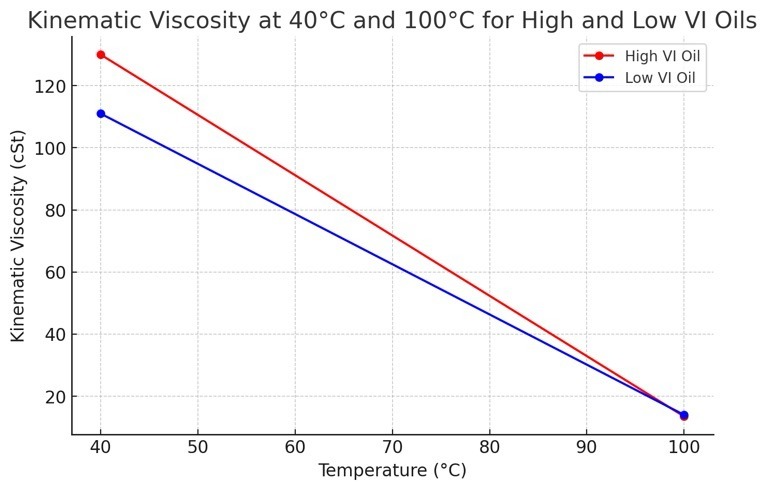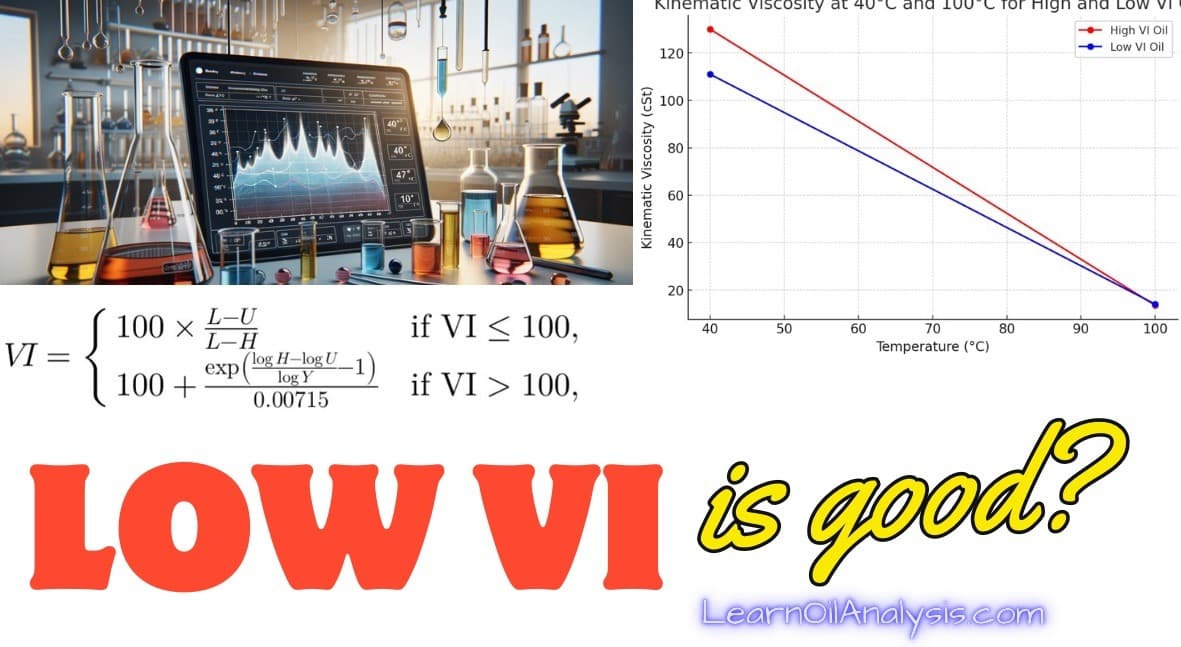In the world of lubrication, the Viscosity Index (VI) is a pivotal metric, often misunderstood and sometimes undervalued. At our Oil Analysis Lab (OAL), we’ve seen how a nuanced understanding of VI can significantly impact machinery maintenance and lubricant selection. Let me share a memorable incident that underscores this.
A Lab Anecdote: The Case of the Misjudged Oil
A sub client of ours who was a customer of one of our lube supplier customers was convinced high VI was the only metric of an oil. He sent us two oil samples: one with a notoriously low VI (the product being suggested by our customer) and another with a high VI, both used in similar temperature conditions. The client was inclined to dismiss the low VI oil due to prevalent misconceptions that high VI is more stable and better. Our analysis, however, revealed a twist: the low VI oil performed exceptionally well in their specific, stable temperature environment, while the high VI oil, though more versatile, was an unnecessary expense in this case. It gets you thinking doesn’t it. How can a test give such a black and white opinion to someone?
I remember a German customer of mine once told me they witnessed the salesman for a famous multigrade engine oil in a monograde market put the monograde competitions oil in the freezer and showed how “gooey” it went and he managed to switch a fleet of 700 industrial engines to this oil. The fact that these engines spent 99% of their lives at a very warm 80’C seemed to have been missed. Hence VI although useful for changing temperatures isn’t the be all and end all for when the temperature is stable. So what is viscosity index?
Understanding Viscosity Index
Well not to frighten you but this is the formula:

Y is the oil’s kinematic viscosity at 100°C.
L and H are the viscosities at 40°C for two hypothetical oils of VI 0 and 100 respectively, that have the same viscosity at 100°C as the oil which is being determined for VI.
VI is a unitless number and thankfully I have never had to manually calculate the formula in my life as the maths scares me too. Thankfully the first iteration I came across was nicely converted into excel formulas for my father by a maths and physics PhD inventor in the field. I personally found the code far easier to chunk up and made the free tools for this website inspired by this logic.
VI indicates how an oil’s viscosity changes with temperature. High VI oils exhibit minimal viscosity changes across temperature variations, whereas low VI oils show more significant changes.

Beyond Standard Measurements
Traditionally, VI is calculated using kinematic viscosity measurements at 40°C and 100°C. These are arbitrary numbers chosen based on the two most popular viscosity measurement standards of 40 and 100 Celsius for ISO and SAE respectively. Nearly all baths are calibrated to these temperatures in commercial labs and they extrapolate all other temperatures from the VI.
However, at OAL, we’ve pushed the boundaries by measuring viscosities from -40°C to +120°C to cover customers actual operating temperature properties including viscosity. This expanded range allows us to provide comprehensive temperature profiles, offering a more precise understanding for selecting oils. For example many pumps have a maximum viscosity that many oils exceed before their pour points. You wouldn’t need this routinely but it’s a great help in selecting a lubricant for your machinery.
It is all about tailoring the analysis to your requirements. Do you really need a high VI or would it be a hindrance?
High Viscosity Index: Pros and Cons
Pros:
- Enhanced Stability: These oils maintain consistency in various temperatures, crucial for equipment used in fluctuating climates such as vehicle engines that have regular stop starts.
- Optimal Protection: They ensure reliable lubrication film thickness at higher temperatures, safeguarding against wear.
- Energy efficiency – the higher the VI the less energy used during start ups.
Cons:
- Cost Considerations: Advanced formulations make these oils pricier and depending on the additives used they can shear in use making the oil dangerously thin at operating temperatures.
- Redundancy in Stable Climates: In environments with stable temperatures, the benefits might not justify the higher cost.
- Poor pour points – Certainly if opting for paraffiic oils with high VIs the cold temperature properties may be impacted.
Low Viscosity Index: Pros and Cons
Pros:
- Cost Efficiency: More affordable, these oils are suitable for stable temperature operations.
- Desirable to be thin when hot: if the oil is used in heat transfer like electrical oils or thermal oils the lower the VI the better as you want the oil to go thin to rapidly move to allow fresh oil to cool the area.
Cons:
- Temperature Sensitivity: Performance can vary significantly with temperature changes.
- Risk of Inadequate Lubrication: Fluctuating viscosity can lead to insufficient lubrication, potentially increasing wear and tear.
Real-World Applications
High VI Oils: Ideal for machinery in variable climates or outdoor equipment experiencing wide temperature ranges.
Low VI Oils: Suited for machinery in controlled environments, such as indoor industrial setups or industrial heat transfer.
The Full Picture
In our lab, if you are selecting an oil we recommend to complement VI analysis with a complete oil profile examination across the temperatures. However, we also consider factors like additive content, base oil type, and contamination levels. This holistic approach helps in making informed decisions beyond just the VI.
Our capability to measure viscosities across an extensive temperature range is a game-changer. It allows us to provide detailed profiles, helping clients understand how their oils will perform in specific operational conditions. This service is an add-on, offering invaluable insights for selecting the most suitable oil.
Conclusion
The lesson from today’s article and years of experience is clear: low VI isn’t inherently bad, and high VI isn’t universally ideal. It’s about matching the oil’s characteristics with the operational demands. At our lab, we pride ourselves on providing detailed, temperature-specific viscosity profiles, guiding our clients towards optimal oil selection.
For more personalized insights or to explore our unique temperature profiling services, please click the ‘Contact Us’ button on this page. Our team is ready to assist with your specific oil analysis needs, offering expertise that spans beyond standard measurements.


